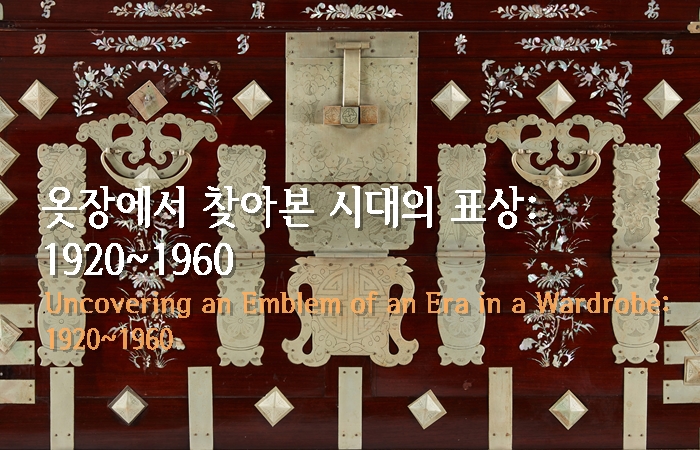- 글번호
- 195695
- 작성일
- 2023.06.12
- 수정일
- 2023.06.12
- 작성자
- 박물관
- 조회수
- 386
Uncovering an Emblem of an Era in a Wardrobe: 1920~1960

Daily Life in Modern Culture
Since Korea opened its ports to the world and its culture, political and social changes emerged: there was a shift in Korean culture from being traditional to modern in terms of values, clothing, and housing. This exhibition examines modern lifestyles through clothing storage furniture, which was one of the most important type of furniture placed in the main room(anbang), as well as the clothing it held.
Furniture design was greatly influenced by the modernization of living space: houses during the Joseon dynasty had separate living spaces for male and female, unlike modern living spaces, such as urban style modern hanok or Japanese style housing. For example, a uigori-jang, which is a type of wardrobe that was placed in the male living quarter to hold male clothing, was transformed into a storage unit that could hold blankets and Western-style clothing in the main room during the modern period.


Jang-nong(compound cabinet) is a typical type of modern furniture, which combined two or more styles of furniture from the Joseon period. For example, the bottom would be a bandaji(chest with a hinged front flap), and the top would be used as a wardrobe decorated with jangseok(metal mounts), mother-of-pearl, and mirrors. As a result, people began to store their bedding in a jang(wardrobe) instead of placing them on top of a bandaji or a nong(chest). Furthermore, there were drawers added to these wardrobes, whereas mirrors or glass were used to decorate the doors. The furniture on exhibit represents a modern lifestyle and ranges from a chest inlaid with mother-of-pearl, which was used by the upper-class to flaunt their wealth in the 1920s, to a wardrobe with glass doors that was one of the array of articles necessary for marriage in the 1960s.


The changes in Korean clothing culture during the modern era were influenced by Western-style clothing and modernized traditional costumes. Western style became more dominant in men’s wear compared to women’s wear, which accompanied both Western-style and a modern version of traditional Korean clothing.


Since the time of enlightenment, the design and fabric of hanbok changed due to the development of weaving technology and textiles imported from Japan, U.K., and China: the length of jeogori(traditional jacket) and the shape of barae(the width of a sleeve) changed with time; new materials, such as yangdan(洋緞, foreign satin) from Japan and Hong Kong, velvet, lace, and nylon were used; goreum(ribbon) was replaced with a brooch when fastening a jeogori. These changes are evident in the hanbok collection that is on display in this exhibition.

Uniforms of girl’s schools, where Korean women began to receive modern education, were on the same track of adopting Western-style clothing as were modern women and women in general. Moreover, sewing machines that were invented in modern times innovated sewing technology, which met the explosive rise in demand for clothing during the industrial age. In this exhibition, there are various sewing machines that show hints of that period.

Industrialization, the progress of civilization, rationalism, and the market economy marks the modern period, which is known as an era of trends that resulted from the growing passion for new things. This exhibition presents how traditional furniture and fashion reflect not only how daily lifestyles during the modern period were influenced and changed due to new culture, but also the rise of an era of trends through which people began to express their individualities.
- Place
- SUM
- Period
- 2023. 6. 7. ~ 2023. 12. 29.
- 첨부파일
- 첨부파일이(가) 없습니다.